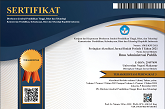The Effects of Profitability, Leverage, and Liquidity on Financial Distress on Retail Companies Listed on Indonesian Stock Exchange
(1) Universitas Widyatama
(2) Universitas Widyatama
(3) Universitas Pamulang
(*) Corresponding Author
DOI: https://doi.org/10.26858/jiap.v10i1.13568
Abstract
The study aims to find out the influence of profitability variables (Return On Assets), Leverage (Debt To Asset Ratio) and liquidity (Current Ratio) on Financial Distress on retail companies listed on the 2014-2018 period Indonesian Stock Exchange. The population of this study is the entire company contained on the Indonesian Stock Exchange listed retail company of the period 2014-2018. The research sample consists of 21 companies used by purposive sampling methods and taken that meet with criteria from predetermined research samples. The data analysis method used is panel data regression analysis (Random Effect) with a significance level of 5 percent. Based on the results of the research that has been conducted led to that, simultaneously Profitability, Leverage and Liquidity variables have an effect on Financial Distress. Partially variable Profitability has a significant positive effect on Financial Distress, Leverage variables have a significant positive effect on Financial Distress, and negatively significant negatively influential Liquidity variables on Financial Distress. The magnitude of the influence of Profitability, Leverage, and Liquidity on Financial Distress amounted to 98.87 percent, while the rest amounted to 1.13 percent was affected by other variables outside of research.
Keywords
Full Text:
PDFReferences
Andersen, T. G., Bollerslev, T., Christoffersen, P. F., & Diebold, F. X. (2013). Financial Risk Measurement for Financial Risk Management. In Handbook of the Economics of Finance. https://doi.org/10.1016/B978-0-44-459406-8.00017-2
Anderson, E. W., Fornell, C., & Lehmann, D. R. (1994). Customer Satisfaction, Market Share, and Profitability: Findings from Sweden. Journal of Marketing. https://doi.org/10.2307/1252310
Brigham, E. F., & Houston, J. F. (2012). Fundamentals of Financial Management. Cengage Learning.
Hery. (2015). Analisis Laporan Keuangan. CAPS.
Horne, J.C. dan Wachowicz, J. M. (2007). Prinsip-Prinsip Manajemen Keuangan. In Prinsip-Prinsip Manajemen Keuangan. https://doi.org/10.4324/9781315641348
Huda, E. N., Paramita, P. D., & Amboningtyas, D. (2019). Analisis Financial Distress dengan Menggunakan Model Altman, Springate dan Zmijewski pada Perusahaan Retail yang Terdaftar di BEI Tahun 2013-2017. Journal of Management, 5(5).
Miller, R. D., & Springate, D. J. (1978). The Relationship of Strategy, Structure and Management Processes. Academy of Management Proceedings, 1978(1), 121–125.
Mulyanti, D. (2016). Manajemen Keuangan Perusahaan. Jurnal Ilmiah Akuntansi.
Munawir. (2005). Analisis Laporan Keuangan. Liberty.
Olalere, O. E., Bin Omar, W. A., & Kamil, S. (2017). Bank Specific and Macroeconomic Determinants of Commercial Bank Profitability: Empirical Evidence from Nigeria. International Journal of Finance & Banking Studies (2147-4486). https://doi.org/10.20525/ijfbs.v6i1.627
Opler, T. C., & Titman, S. (1994). Financial Distress and Corporate Performance. The Journal of Finance. https://doi.org/10.2307/2329214
Outecheva, N. (2007). Corporate Financial Distress : An Empirical Analysis of Distress Risk. Doctoral Dissertation, University of St. Gallen.
Ponsian, N. (2014). The Effect of Working Capital Management on Profitability. International Journal of Economics, Finance and Management Sciences. https://doi.org/10.11648/j.ijefm.20140206.17
Prabowo, A., & Wibowo, A. (2017). Pengaruh Persepsi Harga, Persepsi Kualitas Produk, dan Citra Merek terhadap Keputusan Pembelian Sepeda Motor Yamaha Vixion (Studi: Pengguna Sepeda Motor Yamaha Vixion Dicondongcatur). STIE Widya Wiwaha.
Rengifurwarin, Z. A., Akib, H., & Salam, R. (2018). Snapshot of public service quality in the center for integrated business service (CIBS), cooperative micro small and medium enterprises (CMSME), Maluku Province, Indonesia. Journal of Entrepreneurship Education.
Saunders, A., & Cornett, M. M. (2014). Financial Institutions Management. In McGraw-Hill Education.
Setiawati, M. H. (2017). Analisis Metode Altman Z-Score, Springate, dan Zmijewski untuk Memprediksi Financial Distress pada Perusahaan Food and Beverage yang Terdaftar di Bursa Efek Indonesia (BEI) periode 2011-2015.
sugiyono. (2014). Metode penelitian. Metode Penelitian.
Wong, K. L. (2006). Financial management. In Professional Housing Management Practices in Hong Kong. https://doi.org/10.5005/jp/books/10677_12
Zmijewski, M. E. (1984). Methodological issues related to the estimation of financial distress prediction models. Journal of Accounting Research, 59–82.
Article Metrics
Abstract view : 7069 times | PDF view : 1766 timesRefbacks
- There are currently no refbacks.
Copyright (c) 2020 Neneng Susanti, Ifa Latifa, Denok Sunarsi

This work is licensed under a Creative Commons Attribution 4.0 International License.
Diterbitkan oleh:
Program Studi Ilmu Administrasi Publik
Program Pascasarjana Universitas Negeri Makassar
JIAP Index By:

This work is licensed under a Creative Commons Attribution 4.0 International License.









